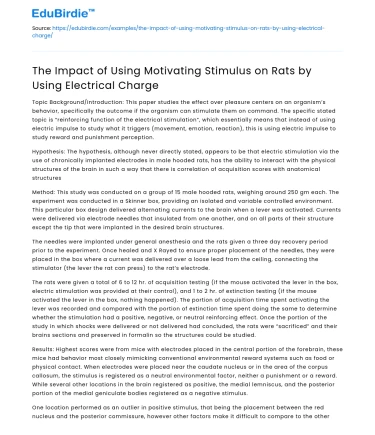Topic Background/Introduction: This paper studies the effect over pleasure centers on an organism’s behavior, specifically the outcome if the organism can stimulate them on command. The specific stated topic is “reinforcing function of the electrical stimulation”, which essentially means that instead of using electric impulse to study what it triggers (movement, emotion, reaction), this is using electric impulse to study reward and punishment perception.
Hypothesis: The hypothesis, although never directly stated, appears to be that electric stimulation via the use of chronically implanted electrodes in male hooded rats, has the ability to interact with the physical structures of the brain in such a way that there is correlation of acquisition scores with anatomical structures
Save your time!
We can take care of your essay
- Proper editing and formatting
- Free revision, title page, and bibliography
- Flexible prices and money-back guarantee
Method: This study was conducted on a group of 15 male hooded rats, weighing around 250 gm each. The experiment was conducted in a Skinner box, providing an isolated and variable controlled environment. This particular box design delivered alternating currents to the brain when a lever was activated. Currents were delivered via electrode needles that insulated from one another, and on all parts of their structure except the tip that were implanted in the desired brain structures.
The needles were implanted under general anesthesia and the rats given a three day recovery period prior to the experiment. Once healed and X Rayed to ensure proper placement of the needles, they were placed in the box where a current was delivered over a loose lead from the ceiling, connecting the stimulator (the lever the rat can press) to the rat’s electrode.
The rats were given a total of 6 to 12 hr. of acquisition testing (if the mouse activated the lever in the box, electric stimulation was provided at their control), and 1 to 2 hr. of extinction testing (if the mouse activated the lever in the box, nothing happened). The portion of acquisition time spent activating the lever was recorded and compared with the portion of extinction time spent doing the same to determine whether the stimulation had a positive, negative, or neutral reinforcing effect. Once the portion of the study in which shocks were delivered or not delivered had concluded, the rats were “sacrificed” and their brains sections and preserved in formalin so the structures could be studied.
Results: Highest scores were from mice with electrodes placed in the central portion of the forebrain, these mice had behavior most closely mimicking conventional environmental reward systems such as food or physical contact. When electrodes were placed near the caudate nucleus or in the area of the corpus callosum, the stimulus is registered as a neutral environmental factor, neither a punishment or a reward. While several other locations in the brain registered as positive, the medial lemniscus, and the posterior portion of the medial geniculate bodies registered as a negative stimulus.
One location performed as an outlier in positive stimulus, that being the placement between the red nucleus and the posterior commissure, however other factors make it difficult to compare to the other data points. Looking at the data collected on behavior of mice in the study, the more indicative of a positive stimulus the results were, the more they pressed the trigger to activate it.
Discussion/Interpretation: These results indicate that the locations in the brain primarily responsible for reward function are likely centered on the septal area, as the rats with electrodes placed there had reaction to stimulus most similar to that in an organic environment. That said, this result only stands under the supported assumption that the rats do not seek the electric stimulation to alleviate pain or reduce some other desire. Expansion: In this experiment, the scientists worked under several assumptions, and although said assumptions are not unreasonable, it would have better supported their results had they run complementary experiments to have comparable data on what it would look like if the rats being studied were to use the electric stimulus to relieve pain or alleviate a different need. This would eliminate or at least reduce the magnitude of the assumption that their results indicated exactly what they intended to study.
From a humanitarian perspective it would likely have been more ethically sound to explore the possibility of studying changes to the rat’s brain with the use of X Ray or MRI type technology, so that they would not have been killed once they had satisfied their experimental purpose. The question of ethicality would also have been more sound had the scientists had some point of comparison for what the rat’s reactions looked like if they were seeking electric stimuli for a reason other than pleasure, as this could have eliminated the aforementioned assumption that the rats were not in pain.
Finally, the experiment could have cross examined its findings with a study of which portions of the brain react under natural environmental stimuli, this would have ensured that the electrode placement was aligned with the portions of the brain that typically exhibit reward function, and could have prevented any question as to the effect of electric stimuli affecting all parts of the brain in a uniform manner.






 Stuck on your essay?
Stuck on your essay?

